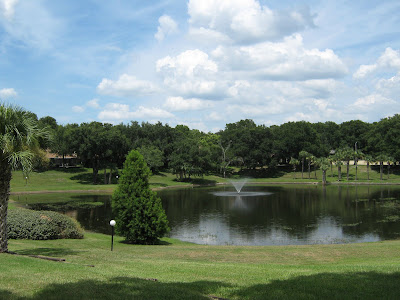
Ducks departing from shore at Cranes Roost Lake
Just over the Orange County Line lies the city of Altamonte Springs. For visitors to Orlando who think they have a handle on the area once they discover the downtown district, it may come as a surprise to find a fully developed outlying urban core just eight miles north of central Orlando. Over the last few years, a really attractive zone has come to maturity around the shores of Crane's Roost Lake on the northwest corner of the Altamonte Mall. Several mid-rise condo buildings and an Embassy Suites Hotel and numerous office buildings are situated along the lake's perimeter.

Picture of the lake from the surrounding boardwalk with a magnificent view of the bridge, along with a crane drying his wings
The park surrounding the lake has been expanded by a boardwalk along its eastern shore that actually juts out into the water and includes canopied overlooks. There is a stage out in the lake as well and it plays host to live performances of all kinds of music several times a month. The shore is dotted with beautiful landscaping, sculptures and fountains that make it a delightful place for a stroll day or night. The whole area attracts throngs for multiple events, topped by a fourth of July celebration called "Red, Hot and Boom" that rivals the display at downtown Orlando's Lake Eola festivities on the same holiday.

View of the Cranes Roost Lake bridge with a view of the Uptown Lofts in the distance
The maturation of this part of the metro into a complete urban nexus means the area has really become, as its planners have chosen to designate it, "Uptown Altamonte." The arrested development caused by the real estate meltdown of 2008 has stopped the completion of the last few pieces of this delightful puzzle, but even without them, the result is hugely successful in embracing the kind of live-work-play atmosphere that so many cities are striving for.

The entrance into the neighborhood of a job we did in Altamonte Springs
In a process that has evolved over the last thirty five years, since the Altamonte Mall opened to resounding good fortune in 1974, the area has really become a great example of the results of dynamic planning carefully implemented on a site with real geographic assets. An excursion here is definitely worth the detour. And you're very likely to see more than a few of the parks namesakes, a wide variety of cranes.

Ducks enjoying a swim on Cranes Roost Lake

 The new Whole Foods Market, which probably has half its expansive area dedicated to prepared food kicks off the east end of the street surrounded by a few other eateries including a sushi restaurant and a New York Bakery.
The new Whole Foods Market, which probably has half its expansive area dedicated to prepared food kicks off the east end of the street surrounded by a few other eateries including a sushi restaurant and a New York Bakery. Heading west the highlights include The Samba Room, Seasons 52 and
Heading west the highlights include The Samba Room, Seasons 52 and 












 South of St. Cloud a view of one of the many cow ranches
South of St. Cloud a view of one of the many cow ranches


